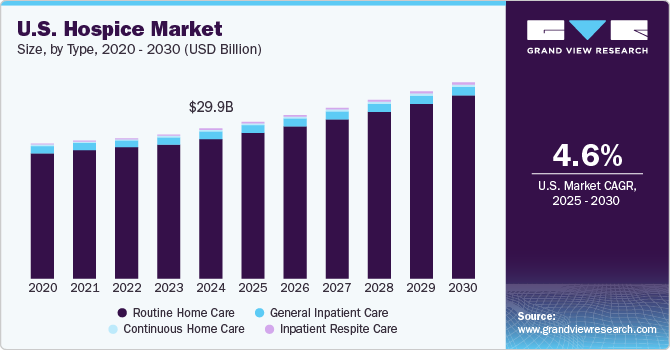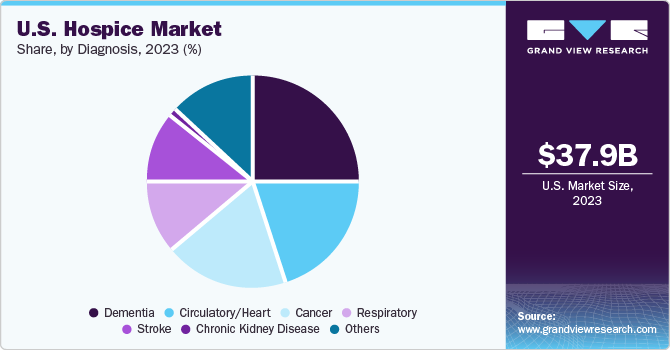- Home
- »
- Medical Devices
- »
-
U.S. Hospice Market Size, Share & Growth Report, 2030GVR Report cover
![U.S. Hospice Market Size, Share & Trends Report]()
U.S. Hospice Market Size, Share & Trends Analysis Report By Type, By Location (Hospice Center, Home Hospice Care), By Diagnosis (Dementia, Cancer), And Segment Forecasts, 2024 - 2030
- Report ID: GVR-3-68038-696-7
- Number of Report Pages: 90
- Format: PDF, Horizon Databook
- Historical Range: 2018 - 2022
- Forecast Period: 2024 - 2030
- Industry: Healthcare
U.S. Hospice Market Size & Trends
The U.S. hospice market size was estimated at USD 37.9 billion in 2023 and is expected to grow at a compound annual growth rate (CAGR) of 8.07% from 2024 to 2030. The growth of the market can be attributed to rising prevalence of chronic diseases among rapidly growing geriatric populations. According to CDC data from November 2022, around 6 in 10 adults in the U.S. are suffering from chronic diseases, and around 4 in 10 have two or more chronic diseases. Hospice provides end-of-life services to such individuals and focuses on improving quality of life through palliative care

Organized home care and hospice programs are regulated by both state and federal governments in the US. hospice and palliative services are highly beneficial for elderly individuals as they help decrease hospitalizations, manage pain and symptoms, and support patients and families in comprehending treatment regimens. These services focus on the body, mind, and spirit of patients. Hospice care standards for federal entitlement programs, especially Medicare, are defined by parts of the Social Security Act (42 USC, Section 1395d, et seq.). The U.S. Code of Federal Regulations (CFR) also includes specific Medicare regulations, such as standards for quality reporting and the appeals process for Medicare Part D prescription coverage.
Diagnosis Insights
Based on diagnosis, the dementia segment held the largest market share of 25.2% in 2023 and is expected to maintain its dominance over the forecast period. Dementia is one of leading causes of mental impairment among older adults in the U.S., contributing to growth of segment. Population suffering from end-stage dementia is more vulnerable to loss of awareness and infections and faces increased difficulty in communicating, which increases need for effective treatment.

Effective end-of-life care prevents and relieves suffering and supports patients in the best possible way. It also reduces caregivers’ burden and ensures optimal treatment decisions. Mortality rate due to Alzheimer’s disease is on rise in the U.S., which ultimately increases demand for palliative care. According to the Alzheimer's Association, in 2023, an estimated 6.7 million Americans aged 65 and above are estimated to be suffering from Alzheimer's dementia. Around 73% of those people are over the age of 75 years.
The cancer segment is expected to hold a considerable CAGR in the near future, owing to growing prevalence of cancer among the geriatric population. The rising preference for palliative care among the families of these elderly patients is anticipated to fuel the segment's growth. According to NHPCO, in 2022, cancer was the third largest category for diagnoses, accounting for around 7.5% of Medicare decedents. Patients with a principal diagnosis of cancer had 55 days of care on average in 2022.
Market Dynamic
Demand for hospice services in the U.S. is expected to rise in coming years due to increasing Medicare reimbursement for hospice and growing demand for end-of-life services. In July 2022, CMS increased the payment for hospice by 3.8% compared to 2022, resulting in a payment of $21.7 million. Besides Medicare, Medicaid, other private insurance, and charity or uncompensated care providers cover the cost of hospice in the U.S.
The number of hospice centers in the U.S. is constantly growing due to the aging population and the increasing number of patients with end-of-life conditions. According to CMS's 2022 Hospice Information Gathering Report, around 1.6 million Medicare beneficiaries received hospice in the U.S. in 2019, and Medicare spent approximately $20.9 billion on these services.
The COVID-19 pandemic has slightly impacted the hospice market in the U.S. as patient visits to centers have reduced due to lower referrals from hospitals. In addition, these centers were utilized to treat COVID-19 patients, adversely impacting their operations. According to a NAHC survey in 2020, nearly two-thirds (61%) of hospices admitted COVID-19-positive patients in their care. However, more than half of those polled said admissions were down in March 2020 compared to March 2019, with more than a quarter of respondents experiencing a 15% or greater decline in admissions.
Currently, hospices have adopted technology substantially, and over 84% of respondents U.S.e telecommunications technology to deliver services to Medicare patients, with 82% saying they U.S. e two-way audiovisual communications. This adoption of technology has positively impacted the overall market.
Type Insights
Based on the type, the market is segmented into continuous home care, routine home care, inpatient respite care, and general inpatient care. The routine home care (RHC) segment held the largest market share of 90.7% in 2023 due to high comfort, favorable reimbursement policies, and routine visits by licensed nurses, physicians, and aides. It has an advantage of receiving constant attention, companionship, and family involvement. In 2022, VITAS Healthcare generated the maximum of its revenue from RHC. According to NHPCO, in 2018, 89.81% of total Medicare spending was for RHC, an increase of 17.8% from 2014.
Other settings, such as inpatient respite care, continuous home care, and general inpatient home care, are anticipated to grow at a steady pace over the forecast period. Continuous home care (CHC) services are short-term services provided at home where symptoms cannot be managed. Furthermore, as the main aim of CHC is to manage acute symptom crises at home, it significantly reduces hospital admissions. A study published in NCBI found that hospice CHC decreases the likelihood of hospitalization and non-enrollment. Thus, it provides comprehensive end-of-life care. These factors are expected to drive segment growth.
However, inpatient home and respite care services are provided in healthcare facilities as symptoms cannot be managed at home. The inpatient respite care segment is expected to grow owing to supportive reimbursement policies for respite care and increasing focus on the mental health of primary care providers.
Location Insights
Based on location, the market is segmented into hospice centers, hospitals, home hospice care, and skilled nursing facilities. The hospice center segment held a maximum revenue share of 58.3% in 2023, owing to benefits offered by these facilities. These centers prevent the need for hospitalization and offer more balanced and controlled care settings.
Hospice centers can be helpful to patients who need round-the-clock care or do not have a caregiver. Hence, many organizations are launching hospice centers at different locations, which is expected to contribute to the market's growth over the forecast period. For instance, in February 2022, Chemed Corporation, a subsidiary of VITAS Healthcare, opened two new hospice in-patient centers in Florida. This initiative by VITAS Healthcare is expected to increase services to 900 patients annually with the opening of new centers.
The home hospice care segment is expected to witness significant growth over the forecast period. This can be attributed to the growing preference of patients and family members. It offers a more comfortable environment to patients along with freedom for visitors. In addition, it saves family members traveling costs required to reach patients. It is a more cost-effective option compared to long-term hospital stays.
Key Companies & Market Share Insights
The market is highly fragmented, with a majority of market share held by key players. Major players in the market are adopting several strategies, such as geographical expansion, partnership & collaboration, and technology integration in the business, to capitalize on consolidating the industry. Key players are strengthening their position in the market through activities such as partnerships, collaborations, mergers, and acquisitions.
- For instance, in March 2023, VITAS Healthcare partnered with WellSky to streamline its operations for advancing innovations with the WellSky Hospice & Palliative solution.
Key U.S. Hospice Companies:
- Chemed Corporation (VITAS Healthcare)
- LHC Group, Inc.
- Amedisys
- Kindred Healthcare Inc.
- Brookdale Senior Living, Inc.
- Accentcare, Inc.
- Crossroads Hospice
- Seasons Hospice & Palliative Care
- Heart to Heart Hospice
- Oklahoma Palliative & Hospice Care
U.S. Hospice Market Report Scope
Report Attribute
Details
Revenue forecast in 2030
USD 65.0 billion
Growth rate
CAGR of 8.07% from 2024 to 2030
Base year for estimation
2023
Historical data
2018 - 2022
Forecast period
2024 - 2030
Report updated
November 2023
Quantitative units
Revenue in USD billion and CAGR from 2024 to 2030
Report coverage
Revenue forecast, company ranking, competitive landscape, growth factors, trends
Segments covered
Location, type, diagnosis
Country scope
U.S.
Key companies profiled
Chemed Corporation; Amedisys; Kindred Healthcare Inc.; Inc.; Brookdale Senior Living, Inc.; LHC Group; Crossroads Hospice; Accentcare, Inc.;Seasons Hospice & Palliative Care; Heart to Heart Hospice; Oklahoma Palliative & Hospice Care
Customization scope
Free report customization (equivalent up to 8 analysts working days) with purchase. Addition or alteration to country, regional & segment scope.
Pricing and purchase options
Avail customized purchase options to meet your exact research needs. Explore purchase options
U.S. Hospice Market Report Segmentation
This report forecasts revenue growth at the country levels and provides an analysis of the latest industry trends and opportunities in each of the sub-segments from 2018 to 2030. For this study, Grand View Research has segmented the U.S. hospice market report based on location, type, and diagnosis:
-
Type Outlook (Revenue, USD Billion, 2018 - 2030)
-
Routine Home Care
-
Continuous Home Care
-
Inpatient Respite Care
-
General Inpatient Care
-
-
Location Outlook (Revenue, USD Billion, 2018 - 2030)
-
Hospice Center
-
Hospital
-
Home Hospice Care
-
Skilled Nursing Facility
-
-
Diagnosis Outlook (Revenue, USD Billion, 2018 - 2030)
-
Dementia
-
Circulatory/Heart
-
Cancer
-
Respiratory
-
Stroke
-
Chronic Kidney Disease
-
Others
-
Frequently Asked Questions About This Report
b. The U.S. hospice market size was estimated at USD 37.9 billion in 2023 and is expected to reach USD 40.8 billion in 2024.
b. The U.S. hospice market is expected to grow at a compound annual growth rate of 8.07% from 2024 to 2030 to reach USD 65.0 billion by 2030.
b. Routine home care segment dominated the U.S. hospice market with a share of 90.7% in 2023 owing to increased comfort, favorable reimbursement policies, and routine visits by licensed nurses, physicians, and aides.
b. Some key players operating in the U.S. hospice market include Kindred Healthcare, Inc.; Chemed Corporation; Amedisys; LHC Group, Inc.; Brookdale Senior Living Solutions; Seasons Hospice & Palliative Care; Crossroads Hospice; AccentCare; Heart to Heart Hospice; and Oklahoma Palliative & Hospice Care.
b. Key factors that are driving the U.S. hospice market growth include rising geriatric population, growing prevalence of chronic conditions, and increasing number of hospice centers.
b. Hospice center dominated the U.S. hospice market with a share of 58.3% in 2023. This is attributable to the increasing demand for hospice centers and strategies adopted by key players to expand their geographical footprints.
Share this report with your colleague or friend.
![gvr icn]()
NEED A CUSTOM REPORT?
We can customize every report - free of charge - including purchasing stand-alone sections or country-level reports, as well as offer affordable discounts for start-ups & universities. Contact us now
![Certified Icon]()
We are GDPR and CCPA compliant! Your transaction & personal information is safe and secure. For more details, please read our privacy policy.
We are committed towards customer satisfaction, and quality service.
"The quality of research they have done for us has been excellent."





